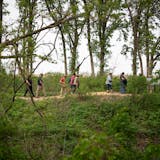If Hy-Vee has its way, the grocery chain's first two Twin Cities stores set to open in September will be the beginning of a long-term shake-up of the area's supermarket business.
Des Moines-based Hy-Vee's quest is to eventually make Minneapolis-St. Paul its top market by sales volume, bigger than its hometown operations and current No. 1 metro area of Kansas City, Mo.
"We see this is as being our largest market some day," Hy-Vee CEO Randy Edeker told the Star Tribune in an interview Friday. "Over the next 10 years, we see steady growth here."
It won't be easy, and will entail wresting business from others. The grocery business is slow growing but highly competitive in most major metro areas, and the Twin Cities area is no exception. Cub Foods leads the market, with strong competition from Wal-Mart, Target, Lunds & Byerlys and others.
Hy-Vee's first two supermarkets in New Hope and Oakdale will come online about 18 months after the company announced it would enter the Twin Cities grocery market. Hy-Vee has secured land for two more stores in Lakeville and Brooklyn Park, and those should open in the second half of 2016.
After Hy-Vee opens its first four stores here, the company plans to add four or five supermarkets annually in the Twin Cities, Edeker said. Eagan and Savage are the next target areas.
Why does Hy-Vee think it can gain a foothold? "I just think we have a unique enough brand to make it work," Edeker said.
Employee-owned Hy-Vee does about $9 billion in annual sales, and has 235 stores in eight states — with 17 in southern Minnesota and its biggest concentration in Iowa. It owns the Des Moines market, is a top player in Omaha and is a leader in Kansas City after Wal-Mart. But given that Kansas City is considerably bigger than Des Moines, it's Hy-Vee's largest market by volume.
![Three weeks ago, Octavio Rodriguez switched from making transmission parts to casting parts for hospital bed brake assemblies at Twin City Die Castings. ] GLEN STUBBE • glen.stubbe@startribune.com Thursday, April 9, 2020 How employee-owned Twin City Die Casting, which just laid off 40 production workers of its 250 employees in what was supposed to be a good year, is trying to accelerate its pivot to growing medical parts business for ventilators, hospital beds, etc as it copes with instan](https://arc.stimg.co/startribunemedia/WNZYKGTZ5IYMUCO3KI5TR3N7WI.jpg?&w=80&ar=1:1&fit=crop)
djoles@startribune.com As boaters flock to Minnesota lakes and rivers this holiday weekend for the unofficial kick-off to the boating season, they'll face more inspections in and out of the water as local cities and counties ramp up their work to stop the spread of invasive species. Across the metro, more boat accesses will be staffed by watercraft inspectors thanks to $10 million funneled to county government programs this year, up from $4.5 million the state allocated last year. ORG XMIT: MIN1505222156290209 ORG XMIT: MIN1506021218440580](https://arc.stimg.co/startribunemedia/34QSKO44B2XKVNUZCO5SLJQSLY.jpg?&w=80&ar=1:1&fit=crop)

